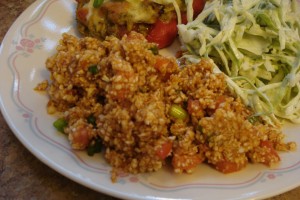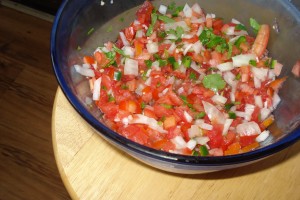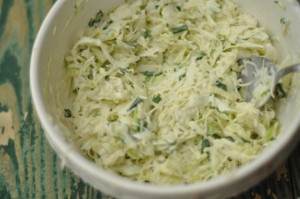I came out of my summer’s week-long vacation with a renewed dedication to low-carb eating. Calorie-counting has become unbearable, and ineffective, since my patiently-awaited weekend splurges turn into overkill, effectively cancelling out the weekday deprivation and counteracting any ground gained. Also, in the effort to avoid unnecessary calories, I found myself avoiding protein-rich foods like meat and fish because of how heavily they weighed on the calorie scale.
Turning again to low-carb living seems the only solution, as it is a diet I can stick to, even over the weekends, where I can “splurge” on richer low-carb foods (or low-carb recipes I don’t have time to make during the week) without actually violating the diet. Weekdays are dedicated to eating comparatively lean meals and many, many vegetables. I’ve discovered, to my surprise, that there are even many vegetables I prefer raw, or almost raw, like diced tomatoes or shredded cabbage, either fresh or slightly warmed.
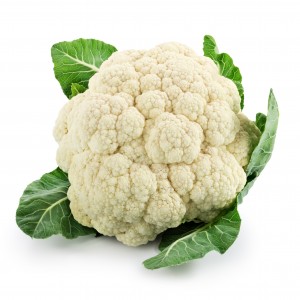 In my low-carb experiments, I’ve discovered a number of pretty reasonable substitutes for the usual carb suspects. Cauliflower makes an excellent mashed “potato,” zucchini and other squash and even cabbage put through the spiralizer make great bed of spaghetti, leafy greens are a surprisingly good stand-in for tortillas. Of course, many of these substitutes aren’t meant to taste the same (actually, I find I like the mashed cauliflower better), but to be functional substitutions that taste good in their own right while mimicking the properties of the erstwhile carb.
In my low-carb experiments, I’ve discovered a number of pretty reasonable substitutes for the usual carb suspects. Cauliflower makes an excellent mashed “potato,” zucchini and other squash and even cabbage put through the spiralizer make great bed of spaghetti, leafy greens are a surprisingly good stand-in for tortillas. Of course, many of these substitutes aren’t meant to taste the same (actually, I find I like the mashed cauliflower better), but to be functional substitutions that taste good in their own right while mimicking the properties of the erstwhile carb.
One carb substitution that has thus far eluded me, however, is finding a good twin for rice. The high glycemic properties of rice can be pretty effectively mitigated by my diabetic friends by cooking it in high fat recipes, such as coconut milk rice or risotto with plenty of butter and cream and cheese. But my motives are fueled by vanity rather than health, and so I’m aiming to give my metabolism some tough love by avoiding anything more carb-rich than your average vegetable in the hopes that it will target the 7-10 pounds causing my vain self to nit-pick.
The most common low-carb suggestion for rice substitution is, once again, cauliflower. While I am extremely happy with its ability to stand in for mashed potatoes, I found my first attempt at cauliflower “rice” a mite disappointing. I endeavored to make a coconut rice on the stovetop. It was tasty enough, but I had texture qualms with the end product. For one, the consistency of the “grain” of the cauliflower rice is… well, inconsistent. I put my cauliflower through the shredder blade of my food processor, and the florets broke up into small pieces, while the stalks were transformed into long shreds, like thickly shredded cheese that never melts. This may just be the perils of using the whole cauliflower, though I will attempt a correction below. Also, the cauliflower, when cooked stovetop in the coconut milk became somewhat limp and somewhat slimy, like cooked cabbage, mushrooms or spinach. I realize, of course, that cauliflower does not have the same liquid-absorbing properties as rice (on the contrary, it has much inherent liquid to shed), but I generally feel that the appeal of many rice dishes (soup and risotto notwithstanding) is the certain dry-ness it provides in contrast to other foods on the plate. Delicate basmati or jasmine rice balances a gravy-like curry, Mexican rice balances creamy re-fried beans and drenched enchiladas, sticky white or fried rice balances a saucy General Tso’s.
Likewise, I would ideally like my cauliflower rice to have the versatility to assume these functions, and so this time, I will attempt a few fixes.
SARAH’S CAULIFLOWER “RICE” MEXICAN-STYLE
1 medium-large head of cauliflower, stems divided from florets
2-4 tablespoons vegetable oil
1 tablespoon minced garlic
1 large onion, chopped
1 or 2 tablespoons chili powder (the Mexican spice mix)
salt to taste
1 (15oz) can of diced tomatoes with juice
1 (6oz) can of tomato paste
1 bouillon cube, chicken or beef, crushed
frozen small mixed vegetables (i.e. corn, peas, diced carrots, etc.), optional
Preheat oven to 400. Rice your cauliflower.

Cauliflower “riced”
Okay, at this stage, I’m going to try a different approach than last time. I separated the florets from the stems and I’m going to process the stems first using the regular food processor blade until they are a bit more “riced” than the “cheese shred” cauliflower I got last time. Before putting them in the processor, I additionally cut them into smaller chunks so there wouldn’t be pieces of dramatically different size. I don’t want smaller pieces getting pulverized into cauliflower dust while I wait for the larger pieces to break up. This process worked well to get the cauliflower divided up more evenly. To be honest, the end result really is more like couscous than rice, but at this stage, I say same difference if it turns out well. I also put the cauliflower in a large kitchen towel to absorb extra moisture right after I riced it.
Process the cauliflower stems first in a large food processor, then the florets. Depending on the size of the cauliflower you may need to process in batches. Spread the cauliflower “rice” across a large, shallow backing dish. Toss with oil, garlic, onions and spices. Roast in the oven for 10 minutes, stir, and then return for another 10 minutes.
Meanwhile, combine the remaining ingredients in a medium sized bowl.
I did not use the small mixed vegetables this time around. I also decided to puree the tomato mixture with my immersion blender because the diced tomato pieces were so large.
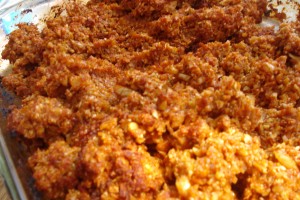 Stir the tomato mixture into the roasted cauliflower rice until well-combined. Return to the oven. Bake uncovered at 400, stirring every 10 minutes, until much of the liquid has evaporated and cauliflower is lightly browned on top. Serve with your favorite Mexican main dish.
Stir the tomato mixture into the roasted cauliflower rice until well-combined. Return to the oven. Bake uncovered at 400, stirring every 10 minutes, until much of the liquid has evaporated and cauliflower is lightly browned on top. Serve with your favorite Mexican main dish.
This time around, the rice turned out pretty well. My efforts to reduce the liquid in this recipe, and the strategy to bake uncovered eliminated the sliminess of my last attempt. The cauliflower still is not overall as “dry” as rice, but it was a worthy substitute. This recipe gives me hope for future cauliflower “rice” recipes.
Some online recipes for cauliflower rice suggest that it also works well raw, which I imagine is another good strategy for eliminating the sliminess of too much liquid. Perhaps my next attempt will be a raw recipe.
